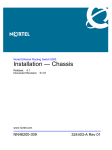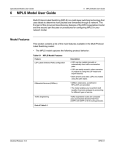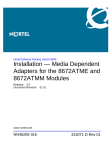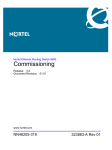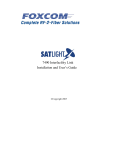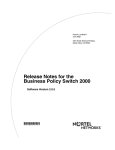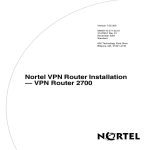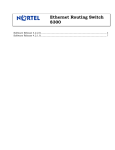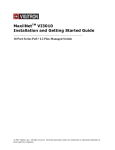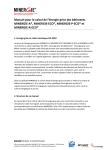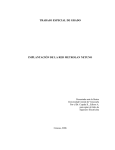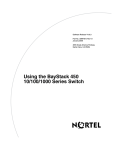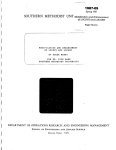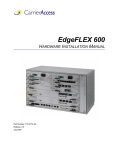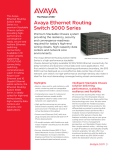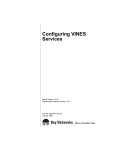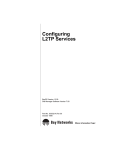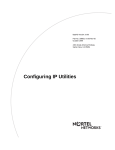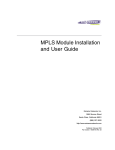Download Nortel Networks HotWire 8600 User's Manual
Transcript
Nortel Ethernet Routing Switch 8600
Terminology
Release: 5.0
Document Revision: 01.01
www.nortel.com
NN46205-102
.
323376-A Rev 01
Nortel Ethernet Routing Switch 8600
Release: 5.0
Publication: NN46205-102
Document status: Standard
Document release date: 30 May 2008
Copyright © 2008 Nortel Networks
All Rights Reserved.
Printed in Canada and the United States of America
LEGAL NOTICE
While the information in this document is believed to be accurate and reliable, except as otherwise expressly
agreed to in writing NORTEL PROVIDES THIS DOCUMENT "AS IS" WITHOUT WARRANTY OR CONDITION OF
ANY KIND, EITHER EXPRESS OR IMPLIED. The information and/or products described in this document are
subject to change without notice.
Nortel, the Nortel logo, and the Globemark are trademarks of Nortel Networks.
SANS is a trademark of The SANS Institute.
All other trademarks are the property of their respective owners.
ATTENTION
For information about the software license, read "Software license" in this guide.
.
3
.
Contents
Software license
5
New in this release
9
Other changes 9
Terminology 9
Nortel Ethernet Routing Switch 8600
Terminology
NN46205-102 01.01 Standard
30 May 2008
Copyright © 2008 Nortel Networks
.
4
Introduction
11
A
13
B
17
C
21
D
25
E
29
F
31
G
33
H
35
I
37
J
41
L
43
M
47
N
53
O
55
P
57
Q
63
R
65
S
71
T
77
U
81
V
83
W
85
Nortel Ethernet Routing Switch 8600
Terminology
NN46205-102 01.01 Standard
30 May 2008
Copyright © 2008 Nortel Networks
.
5
.
Software license
This section contains the Nortel Networks software license.
Nortel Networks Inc. software license agreement
This Software License Agreement ("License Agreement") is between
you, the end-user ("Customer") and Nortel Networks Corporation and
its subsidiaries and affiliates ("Nortel Networks"). PLEASE READ THE
FOLLOWING CAREFULLY. YOU MUST ACCEPT THESE LICENSE
TERMS IN ORDER TO DOWNLOAD AND/OR USE THE SOFTWARE.
USE OF THE SOFTWARE CONSTITUTES YOUR ACCEPTANCE OF
THIS LICENSE AGREEMENT. If you do not accept these terms and
conditions, return the Software, unused and in the original shipping
container, within 30 days of purchase to obtain a credit for the full
purchase price.
"Software" is owned or licensed by Nortel Networks, its parent or one of
its subsidiaries or affiliates, and is copyrighted and licensed, not sold.
Software consists of machine-readable instructions, its components, data,
audio-visual content (such as images, text, recordings or pictures) and
related licensed materials including all whole or partial copies. Nortel
Networks grants you a license to use the Software only in the country
where you acquired the Software. You obtain no rights other than those
granted to you under this License Agreement. You are responsible for the
selection of the Software and for the installation of, use of, and results
obtained from the Software.
1. Licensed Use of Software. Nortel Networks grants Customer a
nonexclusive license to use a copy of the Software on only one machine
at any one time or to the extent of the activation or authorized usage level,
whichever is applicable. To the extent Software is furnished for use with
designated hardware or Customer furnished equipment ("CFE"), Customer
is granted a nonexclusive license to use Software only on such hardware
or CFE, as applicable. Software contains trade secrets and Customer
agrees to treat Software as confidential information using the same care
and discretion Customer uses with its own similar information that it does
not wish to disclose, publish or disseminate. Customer will ensure that
anyone who uses the Software does so only in compliance with the terms
Nortel Ethernet Routing Switch 8600
Terminology
NN46205-102 01.01 Standard
30 May 2008
Copyright © 2008 Nortel Networks
.
6 Software license
of this Agreement. Customer shall not a) use, copy, modify, transfer
or distribute the Software except as expressly authorized; b) reverse
assemble, reverse compile, reverse engineer or otherwise translate the
Software; c) create derivative works or modifications unless expressly
authorized; or d) sublicense, rent or lease the Software. Licensors of
intellectual property to Nortel Networks are beneficiaries of this provision.
Upon termination or breach of the license by Customer or in the event
designated hardware or CFE is no longer in use, Customer will promptly
return the Software to Nortel Networks or certify its destruction. Nortel
Networks may audit by remote polling or other reasonable means to
determine Customer’s Software activation or usage levels. If suppliers of
third party software included in Software require Nortel Networks to include
additional or different terms, Customer agrees to abide by such terms
provided by Nortel Networks with respect to such third party software.
2. Warranty. Except as may be otherwise expressly agreed to in
writing between Nortel Networks and Customer, Software is provided
"AS IS" without any warranties (conditions) of any kind. NORTEL
NETWORKS DISCLAIMS ALL WARRANTIES (CONDITIONS) FOR THE
SOFTWARE, EITHER EXPRESS OR IMPLIED, INCLUDING, BUT NOT
LIMITED TO THE IMPLIED WARRANTIES OF MERCHANTABILITY AND
FITNESS FOR A PARTICULAR PURPOSE AND ANY WARRANTY OF
NON-INFRINGEMENT. Nortel Networks is not obligated to provide support
of any kind for the Software. Some jurisdictions do not allow exclusion
of implied warranties, and, in such event, the above exclusions may not
apply.
3. Limitation of Remedies. IN NO EVENT SHALL NORTEL
NETWORKS OR ITS AGENTS OR SUPPLIERS BE LIABLE FOR ANY
OF THE FOLLOWING: a) DAMAGES BASED ON ANY THIRD PARTY
CLAIM; b) LOSS OF, OR DAMAGE TO, CUSTOMER’S RECORDS,
FILES OR DATA; OR c) DIRECT, INDIRECT, SPECIAL, INCIDENTAL,
PUNITIVE, OR CONSEQUENTIAL DAMAGES (INCLUDING LOST
PROFITS OR SAVINGS), WHETHER IN CONTRACT, TORT OR
OTHERWISE (INCLUDING NEGLIGENCE) ARISING OUT OF
YOUR USE OF THE SOFTWARE, EVEN IF NORTEL NETWORKS,
ITS AGENTS OR SUPPLIERS HAVE BEEN ADVISED OF THEIR
POSSIBILITY. The forgoing limitations of remedies also apply to any
developer and/or supplier of the Software. Such developer and/or supplier
is an intended beneficiary of this Section. Some jurisdictions do not allow
these limitations or exclusions and, in such event, they may not apply.
4.
General
1. If Customer is the United States Government, the following paragraph
shall apply: All Nortel Networks Software available under this License
Agreement is commercial computer software and commercial computer
Nortel Ethernet Routing Switch 8600
Terminology
NN46205-102 01.01 Standard
30 May 2008
Copyright © 2008 Nortel Networks
.
Nortel Networks Inc. software license agreement
7
software documentation and, in the event Software is licensed for
or on behalf of the United States Government, the respective rights
to the software and software documentation are governed by Nortel
Networks standard commercial license in accordance with U.S. Federal
Regulations at 48 C.F.R. Sections 12.212 (for non-DoD entities) and
48 C.F.R. 227.7202 (for DoD entities).
2. Customer may terminate the license at any time. Nortel Networks
may terminate the license if Customer fails to comply with the terms
and conditions of this license. In either event, upon termination,
Customer must either return the Software to Nortel Networks or certify
its destruction.
3. Customer is responsible for payment of any taxes, including personal
property taxes, resulting from Customer’s use of the Software.
Customer agrees to comply with all applicable laws including all
applicable export and import laws and regulations.
4. Neither party may bring an action, regardless of form, more than two
years after the cause of the action arose.
5. The terms and conditions of this License Agreement form the complete
and exclusive agreement between Customer and Nortel Networks.
6. This License Agreement is governed by the laws of the country in
which Customer acquires the Software. If the Software is acquired in
the United States, then this License Agreement is governed by the
laws of the state of New York.
Nortel Ethernet Routing Switch 8600
Terminology
NN46205-102 01.01 Standard
30 May 2008
Copyright © 2008 Nortel Networks
.
8 Software license
Nortel Ethernet Routing Switch 8600
Terminology
NN46205-102 01.01 Standard
30 May 2008
Copyright © 2008 Nortel Networks
.
9
.
New in this release
The following section details what’s new in Nortel Ethernet Routing Switch
8600 Terminology, NN46205-102 for Release 5.0:
•
“Other changes” (page 9)
Other changes
For information about changes that are not feature-related, see the
following sections:
Terminology
Nortel Ethernet Routing Switch 8600 Terminology, NN46205-102 is a new
document for Release 5.0. This document consolidates all terminology and
acronyms into one document. Use this document for information about
common acronyms and terms used in the Nortel Ethernet Routing Switch
8600 documentation.
Nortel Ethernet Routing Switch 8600
Terminology
NN46205-102 01.01 Standard
30 May 2008
Copyright © 2008 Nortel Networks
.
10 New in this release
Nortel Ethernet Routing Switch 8600
Terminology
NN46205-102 01.01 Standard
30 May 2008
Copyright © 2008 Nortel Networks
.
11
.
Introduction
This document provides information about the terms and acronyms used in
the Nortel Ethernet Routing Switch 8600 documentation.
Navigation
•
•
•
•
•
•
•
•
•
•
•
•
•
•
•
•
•
•
•
•
“A” (page 13)
“B” (page 17)
“C” (page 21)
“D” (page 25)
“E” (page 29)
“F” (page 31)
“G” (page 33)
“H” (page 35)
“I” (page 37)
“J” (page 41)
“L” (page 43)
“M” (page 47)
“N” (page 53)
“O” (page 55)
“P” (page 57)
“Q” (page 63)
“R” (page 65)
“S” (page 71)
“T” (page 77)
“U” (page 81)
Nortel Ethernet Routing Switch 8600
Terminology
NN46205-102 01.01 Standard
30 May 2008
Copyright © 2008 Nortel Networks
.
12 Introduction
•
•
“V” (page 83)
“W” (page 85)
Nortel Ethernet Routing Switch 8600
Terminology
NN46205-102 01.01 Standard
30 May 2008
Copyright © 2008 Nortel Networks
.
13
.
A
access control entry (ACE)
One of the filter rules that comprise an access
control list (ACL). A filter rule statement defines
a pattern (in a packet) and the desired behavior
for packets that carry the pattern. When the
packets match an ACE rule, the specified action
executes.
access control list (ACL)
An ordered list of filter rules referred to as
access control entries. The ACEs provide
specific actions, such as dropping packets within
a specified IP range, or a specific Transmission
Control Protocol (TCP) or User Datagram
Protocol (UDP) port or port range. When an
ingress or egress packet meets the match
criteria specified in one or more ACEs within an
ACL, the corresponding action executes.
access control template (ACT)
Defines the selection of match fields for a given
ACL. Before you add an ACE to an ACL, you
must first associate the ACL with an existing
ACT.
add/drop multiplexer (ADM)
A network element in which facilities are
added, dropped, or passed directly through for
transmission to other network elements.
Address Resolution Protocol (ARP)
Maps an IP address to a physical machine
address, for example, maps an IP address to an
Ethernet media across control (MAC) address.
Nortel Ethernet Routing Switch 8600
Terminology
NN46205-102 01.01 Standard
30 May 2008
Copyright © 2008 Nortel Networks
.
14 A
address resolution unit (ARU)
An application specific integrated circuit (ASIC)
that makes forwarding decisions that do not
require CPU activity and, therefore; does not
adversely affect forwarding speed.
Advanced Encryption Standard (AES)
A privacy protocol. AES is the current encryption
standard (FIPS-197) intended for use by U.S.
government organizations to protect sensitive
information.
aggregate
A prefix length that is formed by combining
several specific prefixes. The resulting prefix is
used to combine blocks of address space into a
single routing announcement.
American Standard Code for Information Interchange
(ASCII)
A code for representing characters in computers.
ASCII uses uppercase and lowercase alphabetic
letters, numeric digits, and special symbols.
application-specific integrated circuit (ASIC)
A application-specific integrated circuit
developed to perform more quickly and efficiently
than a generic processor.
area border router (ABR)
A router attached to two or more areas inside an
Open Shortest Path First (OSPF) network. ABRs
play an important role in OSPF networks by
condensing the amount of disseminated OSPF
information.
asymmetric digital subscriber line (ADSL)
A standard that allows digital broadband (over 6
Mbit/s) signals and plain old telephone service to
transmit up to 12 000 feet over a twisted copper
pair.
Asynchronous Transfer Mode (ATM)
A transfer mode that organizes information into
cells and the recurrence of cells depends on the
required or instantaneous bit rate.
Nortel Ethernet Routing Switch 8600
Terminology
NN46205-102 01.01 Standard
30 May 2008
Copyright © 2008 Nortel Networks
.
Navigation
15
attenuation
The decrease in signal strength in an optical fiber
caused by absorption and scattering.
attribute
A unit of data that is used by BGP to describe
any of the following prefixes: AS-PATH,
LOCAL-PREF, NEXT-HOP, and so on.
automatic protection switching (APS)
A Synchronous Optical Network (SONET)
feature that protects against line failure.
AS (autonomous system)
A set of routers under a single technical
administration, using a single IGP and common
metrics to route packets within the AS, and using
an EGP to route packets to other ASs.
AS confederation
A single logical AS that comprises multiple
sub-ASs to ensure scalability.
autonomous system border router (ASBR)
A router attached at the edge of an OSPF
network. An ASBR uses one or more interfaces
that run an interdomain routing protocol such
as BGP. In addition, a router distributing static
routes or Routing Information Protocol (RIP)
routes into OSPF is considered an ASBR.
ASN (autonomous system number)
A two-byte number that is used to identify a
specific AS.
Nortel Ethernet Routing Switch 8600
Terminology
NN46205-102 01.01 Standard
30 May 2008
Copyright © 2008 Nortel Networks
.
16 A
Nortel Ethernet Routing Switch 8600
Terminology
NN46205-102 01.01 Standard
30 May 2008
Copyright © 2008 Nortel Networks
.
17
.
B
backplane forwarding module (BFM)
Connects the switching module on the Web
Switching Module (WSM) and SSL Acceleration
Module (SAM) to the Nortel Ethernet Routing
Switch 8600 backplane.
backup designated router (BDR)
Assumes the designated router (DR) role for the
Open Shortest Path First (OSPF) protocol if the
DR fails.
bandwidth
A measure of transmission capacity for a
particular pathway, expressed in megabits per
second (Mbit/s).
BAP memory controller (BMC)
A Field Programmable Gate Array (FPGA)
device on the R module.
basic rate interface (BRI)
A type of Integrated Services Digital Network
(ISDN) access provided by a set of time division
multiplexed digital channels that include two
B-channels at 64 kbit/s (for digitized voice and
data), one D-channel at 16 kbit/s (for signaling
information), and one or more maintenance
channels.
Baysecure Access Control (BSAC)
A Nortel Remote Authentication Dial-In User
Service (RADIUS) server.
Nortel Ethernet Routing Switch 8600
Terminology
NN46205-102 01.01 Standard
30 May 2008
Copyright © 2008 Nortel Networks
.
18 B
bit error rate (BER)
The ratio of the number of bit errors to the
total number of bits transmitted in a given time
interval.
BGP (Border Gateway Protocol)
An inter-domain routing protocol that provides
loop-free inter-domain routing between
autonomous systems (ASs) or within an AS.
BGP neighbor
BGP routers that have interfaces to a common
network.
BGP peer
A relationship that is formed between any two
routers that open a TCP connection to each
other for the purpose of exchanging routing
informations.
BGP session
An active connection between two routers
running BGP.
BGP speaker
An entity within a BGP router that is used to
communicate with other BGP speakers by
establishing a peer-to-peer session.
bit interleaved parity (BIP)
A simple parity check mechanism.
blade
A synonym for a line card.
Bootstrap Protocol (BootP)
A User Datagram Protocol (UDP)/Internet
Protocol (IP)-based protocol that a booting host
uses to configure itself dynamically and without
user supervision.
Nortel Ethernet Routing Switch 8600
Terminology
NN46205-102 01.01 Standard
30 May 2008
Copyright © 2008 Nortel Networks
.
Navigation
19
bootstrap router (BSR)
A dynamically elected Protocol Independent
Multicast (PIM) router that collects information
about potential Rendezvous Point routers and
distributes the information to all PIM routers in
the domain.
Border Gateway Protocol (BGP)
An exterior gateway protocol that routers use in
different autonomous systems (AS) to exchange
routing information.
boundary port
A bridge port that attaches a Multiple Spanning
Tree (MST) bridge to a LAN in another region.
Breaker Interface Panel (BIP)
A central rack location that connects redundant
input DC-power feeds and routes to one or two
8010co chassis. The BIP provides an alarm
module and display panel that monitors system
components, generates alarms, and controls
LED status indicators.
Bridge Protocol Data Unit (BPDU)
A data frame used to exchange information
among the bridges in local or wide area networks
for network topology maintenance.
burst tolerance (BT)
For ATM traffic, the maximum burst size (MBS)
minus 1 multiplied by the difference between
the peak cell rate (PCR) and sustained cell rate
(SCR) intervals.
Nortel Ethernet Routing Switch 8600
Terminology
NN46205-102 01.01 Standard
30 May 2008
Copyright © 2008 Nortel Networks
.
20 B
Nortel Ethernet Routing Switch 8600
Terminology
NN46205-102 01.01 Standard
30 May 2008
Copyright © 2008 Nortel Networks
.
21
.
C
cable assembly
An optical-fiber cable with connectors installed
on one or both ends. The cable assembly
interconnects the cabling system with
opto-electronic equipment at either end of the
system. Cable assemblies with connectors only
on one end are called pigtails. Cable assemblies
with connectors on both ends are called jumpers
or patch cords.
cable plant
All the optical elements, such as fiber connectors
and splices, between a transmitter and a
receiver.
candidate bootstrap router (C-BSR)
Provides backup protection in case the primary
rendezvous point (RP) or boostrap router (BSR)
fails. Protocol Independent Multicast (PIM) uses
the BSR and C-BSR.
Central Office (CO)
A major equipment center that serves the
communication traffic of a specific geographical
area.
central processor unit (CPU)
The main system processor that resides on the
CSU.
Challenge Handshake Protocol (CHAP)
An access protocol that exchanges a random
value between the server and the client and is
encrypted with a challenge password.
Nortel Ethernet Routing Switch 8600
Terminology
NN46205-102 01.01 Standard
30 May 2008
Copyright © 2008 Nortel Networks
.
22 C
Circuitless IP
A virtual interface that does not map to any
physical interface. This interface is often called
a loopback.
class of service (CoS)
A method used to manage traffic congestion
based on the CoS level assigned to the packet.
classless interdomain routing (CIDR)
The protocol defined in RFCs 1517 and 1518 for
using subnetwork masks, other than the defaults
for IP address classes.
cluster
One or more route reflectors and their associated
clients that form a relationship where the
designated route reflectors provide route
reflection for their clients, as well as nonclient
peers.
coarse wavelength division multiplexing (CWDM)
A technology that uses multiple optical signals
with different wavelengths to simultaneously
transmit in the same direction over one fiber, and
then separates by wavelength at the distant end.
command line interface (CLI)
A nongraphical user interface. When you use
a CLI, you respond to a prompt by typing a
command. After you enter the command, you
receive a system response.
common and internal spanning tree (CIST)
The single spanning tree calculated by the
Spanning Tree Protocol (STP) and Rapid
Spanning Tree Protocol (RSTP), and Multiple
Spanning Tree Protocol (MSTP) to ensure that
all LANs in a bridged Local Area Network (LAN)
are simply and fully connected.
common spanning tree (CST)
The single spanning tree calculated by STP,
RSTP, and MSTP to connect multiple spanning
tree (MST) regions.
Nortel Ethernet Routing Switch 8600
Terminology
NN46205-102 01.01 Standard
30 May 2008
Copyright © 2008 Nortel Networks
.
Navigation
23
community
A BGP attribute that contains a list of 32-bit
values used to identify a route as belonging
to a category of routes. All of the routes in the
category are treated equally by routing policies.
constant bit rate (CBR)
A data service that conveys bits regularly in
time and at a constant rate, between source
(transmitter) and sink (receiver), for example,
follows a timing source or clock.
Custom AutoNegotiation Advertisement (CANA)
An enhancement of the IEEE 802.3
autonegotiation process on the 10/100/1000
copper ports. CANA offers improved control
over the autonegotiation process. The
system advertises all port capabilities that for
tri-speed ports include 10 Mb/s, 100 Mb/s,
1000 Mb/s speeds and duplex and half-duplex
modes of operation. This advertisement
results in autonegotiation between the local
and remote end that settles on the highest
common denominator. CANA can advertise a
user-defined subset of the capabilities that settle
on a lower or particular capability.
customer edge (CE)
A router or switch located at a customer site that
connects to a provider edge (PE) router.
customer premise equipment (CPE)
Equipment or inside wiring at the customer site
that connects to telecommunications equipment.
cyclic redundancy check (CRC)
Ensures frame integrity is maintained during
transmission. The CRS performs a computation
on frame contents before transmission and
on the receiving device. The system discards
frames that do not pass the CRC.
Nortel Ethernet Routing Switch 8600
Terminology
NN46205-102 01.01 Standard
30 May 2008
Copyright © 2008 Nortel Networks
.
24 C
Nortel Ethernet Routing Switch 8600
Terminology
NN46205-102 01.01 Standard
30 May 2008
Copyright © 2008 Nortel Networks
.
25
.
D
Data Encryption Standard (DES)
A cryptographic algorithm that protects
unclassified computer data. The National
Institute of Standards and Technology publishes
the DES in the Federal Information Processing
Standard Publication 46-1.
Data Communications Equipment (DCE)
A network device (such as a modem) that
establishes, maintains, and terminates a session.
Data Terminating Equipment (DTE)
A computer or terminal on the network that is the
source or destination of signals.
database description (DD) packets
Exchanged when a link is initially established
between neighboring routers that synchronizes
their link state databases. The Open Shortest
Path First (OSPF) protocol uses DD packets.
dampen
Indicates that routes which exhibit instability are
not advertised until the routes become stable for
a minimum time period.
denial-of-service (DoS)
Attacks that prevent a target server or victim
device from performing its normal functions
through flooding, irregular protocol sizes (for
example, ping requests aimed at the victim
server) and application buffer overflows.
Nortel Ethernet Routing Switch 8600
Terminology
NN46205-102 01.01 Standard
30 May 2008
Copyright © 2008 Nortel Networks
.
26 D
dense wavelength division multiplexing (DWDM)
A technology that uses many optical signals
(16 or more) with different wavelengths to
simultaneously transmit in the same direction
across one fiber, and then separates by
wavelength at the distant end.
demultiplexing
The wavelength separation in a wavelengthdivision multiplexing system. The opposite of
multiplexing.
designated router (DR)
A single router elected as the designated router
for the network. In a broadcast or nonbroadcast
multiple access (NBMA) network running the
Open Shortest Path First (OSPF) protocol, a DR
ensures all network routers synchronize with
each other and advertises the network to the rest
of the autonomous system (AS). In a multicast
network running Protocol Independent Multicast
(PIM), the DR acts as a representative router for
directly connected hosts. The DR sends control
messages to the rendezvous point (RP) router,
sends register messages to the RP on behalf of
directly connected sources, and maintains RP
router status information for the group.
Device Manager (DM)
A graphical user interface (GUI) used to
configure and manage the Nortel Ethernet
Routing Switch 8600.
DiffServ (DS) boundary or access point
The edge of a DS domain in which classifiers
and traffic conditioners are deployed.
DS field
Formerly called the IPv4 Type of Service (TOS)
octet or the IPv6 Traffic Class octet. The DS
field provides the Differentiated Services Code
Point (DSCP) that is used for packet forwarding.
These fields are part of the standard IPv4
header.
Nortel Ethernet Routing Switch 8600
Terminology
NN46205-102 01.01 Standard
30 May 2008
Copyright © 2008 Nortel Networks
.
Navigation
27
Differentiated Services Code Point (DSCP)
The first six bits of the DS field. The DSCP uses
packet marking to guarantee a fixed percentage
of total bandwidth to each of several applications
(guarantees Quality of Service).
digital subscriber line (DSL)
In Integrated Services Digital Networks (ISDN),
equipment that provides full-duplex service on
a single twisted metallic pair at a rate sufficient
to support ISDN basic access and additional
framing, timing recovery, and operational
functions.
digital subscriber line access multiplexer (DSLAM)
A network device, at a telephone company
central office, that receives signals from
multiple customer digital subscriber line (DSL)
connections and uses multiplexing techniques to
place the signals on a high-speed backbone line.
Dual port controller (DPC)
A Field Programmable Gate Array (FPGA)
device on the R module.
dispersion
The broadening of input pulses as they travel the
length of an optical fiber. The following types of
dispersion exist:
•
modal dispersion-caused by the many optical
path lengths in a multimode fiber
•
chromatic dispersion-caused by the
differential delay at various wavelengths in an
optical fiber
•
waveguide dispersion-caused by light
traveling through both the core and cladding
materials in single-mode fibers
Distance Vector Multicast Routing Protocol (DVMRP)
A dense mode routing protocol that floods
multicast data to all internetwork routers.
Nortel Ethernet Routing Switch 8600
Terminology
NN46205-102 01.01 Standard
30 May 2008
Copyright © 2008 Nortel Networks
.
28 D
Distributed MultiLink Trunking (DMLT)
A point-to-point connection that aggregates
similar ports from different modules to logically
act like a single port, but with the aggregated
bandwidth.
distribution tree
A set of multicast routers and subnetworks that
allow the group members to receive traffic from a
source.
Domain Name System (DNS)
A system that maps and converts domain and
host names to IP addresses.
downstream node
Refers to the node that the packet enters on the
downstream node.
downstream-on-demand (DoD)
A label switch router (LSR) distributes a forward
equivalence class (FEC) label binding in
response to an explicit request from another
LSR. The Nortel Ethernet Routing Switch 8600
does not support downstream-on-demand.
downstream unsolicited (DU)
An LSR distributes label bindings to LSRs that
do not explicitly request them.
dual inline memory module (DIMM)
A module that contains one or several random
access memory (RAM) chips on a small circuit
board with pins that connect it to the computer
motherboard.
Duplicate Address Detection (DAD)
A method used to discover duplicate addresses
in an IPv6 network.
Dynamic Host Configuration Protocol (DHCP)
A standard Internet protocol that dynamically
configures hosts on an Internet Protocol (IP)
network. DHCP extends the Bootstrap Protocol
(BOOTP).
Nortel Ethernet Routing Switch 8600
Terminology
NN46205-102 01.01 Standard
30 May 2008
Copyright © 2008 Nortel Networks
.
29
.
E
Electromagnetic Interference (EMI)
Electromagnetic radiation released from an
electronic device that disrupts the operation or
performance of another device.
Electrostatic Discharge (ESD)
The discharge of stored static electricity that
can damage electronic equipment and impair
electrical circuitry that results in complete or
intermittent failures.
emulated LAN (ELAN)
A virtual LAN (VLAN) for Asynchronous Transfer
Mode (ATM).
encoder-decoder (CODEC)
Compresses and decompresses audio and video
data.
equal cost multipath (ECMP)
Distributes routing traffic among multiple
equal-cost routes.
Ethernet switches (ES)
A family of frame-based computer networking
technologies for local area networks (LANs).
Ethernet Services Module (ESM)
The ESM serves as the demarcation point
between the enterprise customer and the service
provider and utilizes an Ethernet user-to-network
interface (UNI).
Nortel Ethernet Routing Switch 8600
Terminology
NN46205-102 01.01 Standard
30 May 2008
Copyright © 2008 Nortel Networks
.
30 E
explicit route (ER)
Defines one or more hops in the label switched
path (LSP) in a Multiprotocol Label Switching
(MPLS) network.
explicit path
A Resource Reservation Protocol (RSVP) hop-by
hop tunnel that terminates on an interface IP
address on the egress Label Edge Router (LER).
Extended Unique Identifier (EUI)
A 64-bit format used in assigning addresses
automatically to IPv6 interfaces.
Extensible Authentication Protocol over LAN (EAPoL)
A port-based network access control protocol.
EAPoL provides security in that it prevents users
from accessing network resources before they
are authenticated.
External BGP (EBGP)
A BGP session between two BGP speakers in
different ASs.
Exterior BGP (EBGP)
A Border Gateway Protocol (BGP) used by
routers that exchange information between two
different Autonomous Systems.
Nortel Ethernet Routing Switch 8600
Terminology
NN46205-102 01.01 Standard
30 May 2008
Copyright © 2008 Nortel Networks
.
31
.
F
far end fault indication (FEFI)
Determines that one of two unidirectional fibers,
that form the connection between two switches,
fails.
Feedback Output Queue (FOQ)
A mechanism that helps the Nortel Ethernet
Routing Switch 8600 avoid switch fabric
congestion.
FEC to NHLFE table (FTN)
A lookup table that is consulted for incoming,
unlabeled packets to determine which label
values to use when encapsulating the packet.
(See also Next Hop Label Forwarding Entry
[NHLFE]).
file allocation table (FAT)
A table that the operating system uses to locate
files on a disk.
File Transfer Protocol (FTP)
A protocol that governs transferring files between
nodes, as documented in RFC 959. FTP is not
secure. FTP does not encrypt transferred data.
Use FTP access only after you determine it is
safe in your network.
forward equivalence class (FEC)
Specifies which packets map to a label switched
path (LSP) in a Multiprotocol Label Switching
(MPLS) network.
Frame Check Sequence (FCS)
Nortel Ethernet Routing Switch 8600
Terminology
NN46205-102 01.01 Standard
30 May 2008
Copyright © 2008 Nortel Networks
.
32 F
Nortel Ethernet Routing Switch 8600
Terminology
NN46205-102 01.01 Standard
30 May 2008
Copyright © 2008 Nortel Networks
.
33
.
G
Generalized Regular Expression Parser (GREP)
A Unix command used to search files for lines
that match a given regular expression (RE).
get nearest server (GNS)
A request used by Internetwork Packet
Exchange (IPX) clients to find a login server.
gigabit Ethernet (GE)
Ethernet technology with speeds up to 1 Gbit/s.
Gigabit Interface Converter (GBIC)
A hot-swappable input/output enhancement
component designed for use with Nortel products
to allow Gigabit Ethernet ports to link with other
Gigabit Ethernet ports over various media types.
Global routing engine (GRE)
The base router or routing instance 0 in the
Virtual Router and Forwarder (VRF).
global server load balancing (GSLB)
Serves content from several points to overcome
scalability, availability, and performance issues
inherent in distributing content across multiple
geographic locations.
graphical user interface (GUI)
A graphical (rather than textual) computer
interface.
Nortel Ethernet Routing Switch 8600
Terminology
NN46205-102 01.01 Standard
30 May 2008
Copyright © 2008 Nortel Networks
.
34 G
Nortel Ethernet Routing Switch 8600
Terminology
NN46205-102 01.01 Standard
30 May 2008
Copyright © 2008 Nortel Networks
.
35
.
H
High Availability (HA)
Activates two CPUs simultaneously. The CPUs
exchange topology data so, if a failure occurs,
either CPU can take precedence in less than 1
second with the most recent topology data.
Hypertext Transfer Protocol (HTTP)
Communications protocol for the Web.
Hypertext Transfer Protocol, Secure (HTTPS)
Communications protocol used to access a
secure Web server.
Nortel Ethernet Routing Switch 8600
Terminology
NN46205-102 01.01 Standard
30 May 2008
Copyright © 2008 Nortel Networks
.
36 H
Nortel Ethernet Routing Switch 8600
Terminology
NN46205-102 01.01 Standard
30 May 2008
Copyright © 2008 Nortel Networks
.
37
.
I
incoming label map (ILM)
An index used to map an incoming labeled
packet to an NHLFE.
Institute of Electrical and Electronics Engineers (IEEE)
An international professional society that issues
standards and is a member of the American
National Standards Institute and the International
Standards Institute, and the International
Standards Organization.
integrated service director (ISD)
The processor PCI Mezzanine Card (PrPMC)
and disk drive on a firewall module.
Interior BGP (IBGP)
Routers that use the Border Gateway Protocol
(BGP) within an autonomous system. The router
redistributes BGP information to Interior Gateway
Protocols (IGPs) that run in the autonomous
path.
Interior Gateway Protocol (IGP)
Distributes routing information between routers
that belong to a single autonomous system (AS).
internal router (IR)
A router with interfaces only within a single area
inside an Open Shortest Path First (OSPF)
network.
Nortel Ethernet Routing Switch 8600
Terminology
NN46205-102 01.01 Standard
30 May 2008
Copyright © 2008 Nortel Networks
.
38 I
Internet Assigned Numbers Authority (IANA)
The central registry for various assigned
numbers, for example, Internet protocol
parameters (such as port, protocol, and
enterprise numbers), options, codes, and types.
Internet Control Message Protocol (ICMP)
A collection of error conditions and control
messages exchanged by IP modules in both
hosts and gateways.
Internet Engineering Task Force (IETF)
A standards organization for IP data networks.
Internet Group Management Protocol (IGMP)
A host membership protocol used to arbitrate
membership in multicast services.
Internet Group membership Authentication Protocol
(IGAP)
An authentication and accounting protocol for
clients that receives multicast streams.
Internet Protocol Control Packet (IPCP)
Establishes and configures Internet Protocol data
transmission over a Point-to-Point Protocol link.
Internet Protocol Flow Information eXport (IPFIX)
An IETF standard that improves the Netflow V9
protocol. IPFIX monitors IP flows on the Nortel
Ethernet Routing Switch 8600 platforms, and on
other Nortel switching platforms.
Internet Protocol multicast (IPMC)
The technology foundation for audio and
video streaming, push applications, software
distribution, multipoint conferencing, and proxy
and caching solutions.
Internet Protocol security (IPsec)
A secure version of the Internet Protocol (IP) that
provides optional authentication and encryption
at the packet level.
Nortel Ethernet Routing Switch 8600
Terminology
NN46205-102 01.01 Standard
30 May 2008
Copyright © 2008 Nortel Networks
.
Navigation
39
Internet Protocol version 4 (IPv4)
The protocol used to format packets for the
Internet and many enterprise networks. IPv4
provides packet routing and reassembly.
Internet Protocol version 6 (IPv6)
An improved version of the IP protocol. IPv6
improves the IPv4 limitations of security and user
address numbers.
Internetwork Packet Exchange (IPX)
A network layer protocol. IPX is similar to IP but
does not guarantee packet delivery.
interswitch trunking (IST)
A feature that uses one or more parallel
point-to-point links to connect two aggregation
switches. The two aggregation switches use this
channel to share information and operate as a
single logical switch. Only one interswitch trunk
can exist on each Split Multilink Trunking (SMLT)
aggregation switch.
internal spanning tree (IST)
Runs in a given multiple spanning tree (MST)
region. Within an MST region, you can configure
multiple spanning instances. Instance 0 within a
region is the IST.
Nortel Ethernet Routing Switch 8600
Terminology
NN46205-102 01.01 Standard
30 May 2008
Copyright © 2008 Nortel Networks
.
40 I
Nortel Ethernet Routing Switch 8600
Terminology
NN46205-102 01.01 Standard
30 May 2008
Copyright © 2008 Nortel Networks
.
41
.
J
jitter
The delay variance between received packets.
Packets may not arrive at the destination
address in consecutive order, or on a timely
basis, and the signal can vary from its original
reference timing. This distortion damages
multimedia traffic.
Nortel Ethernet Routing Switch 8600
Terminology
NN46205-102 01.01 Standard
30 May 2008
Copyright © 2008 Nortel Networks
.
42 J
Nortel Ethernet Routing Switch 8600
Terminology
NN46205-102 01.01 Standard
30 May 2008
Copyright © 2008 Nortel Networks
.
43
.
L
label
A fixed length header that an LSR uses to
forward packets along a Label Switched Path
(LSP). A label represents a FEC.
label binding
An association between a label and a FEC,
which can be advertised to neighbors to
establish an LSP.
label advertise mode
This mode (downstream unsolicited or
downstream on demand) determines when the
interface distributes label mappings to the next
hop upstream.
label distribution mode
This mode (independent or ordered) specifies
how an LSR binds a label to a FEC.
Label Distribution Protocol (LDP)
Provides a mechanism for dynamic hop-by-hop
label distribution between routers in a
Multiprotocol Label Switching (MPLS) network.
LDP assigns labels to IGP-learned routes and
distributes the label bindings to its peers, to
establish label switched paths (LSP) through the
network.
LDP target address
IP address of the remote peer to which a
targeted LDP session is formed. On the Ethernet
Routing Switch 8600, this address is equivalent
to the MPLS router ID of the remote peer and the
CLIP address of the egress LER.
Nortel Ethernet Routing Switch 8600
Terminology
NN46205-102 01.01 Standard
30 May 2008
Copyright © 2008 Nortel Networks
.
44 L
label edge router (LER)
Resides at the network edge to initiate and
terminate label switched paths and assign
packets to forward equivalence class (FEC) as
traffic enters the Multiprotocol Label Switching
(MPLS) network.
label information base (LIB)
A table of incoming labels, outgoing labels, and
interface mappings.
label retention mode
This mode (liberal or conservative) specifies
whether or not the interface retains label
bindings that it receives
label stack
MPLS uses a label stack, which can contain
multiple labels. For example, in a stack
containing two labels, the bottom label
represents the egress Peripheral Equipment
(PE) and the top label represents the next hop
along the LSP. To move a packet across the
network, LSRs swap out the top label to forward
the packet to the next hop.
label switched path (LSP)
An end-to-end unidirectional tunnel between
MPLS-enabled routers. Data travels through
the MPLS network over LSPs from the network
ingress to the network egress.
label switched router (LSR)
A core router that operates between the source
and destination LERs in an MPLS network.
LSRs strip off the existing label and applies a
new label that tells the next-hop LSR how to
forward the packet.
label use mode
This mode (immediate or not immediate)
specifies when the interface uses the label for
the next hop.
Nortel Ethernet Routing Switch 8600
Terminology
NN46205-102 01.01 Standard
30 May 2008
Copyright © 2008 Nortel Networks
.
Navigation
45
last member query interval (LMQI)
The time between when the last IGMP member
leaves the group and the stream stops.
latency
The time between when a node sends a
message and receipt of the message by another
node; also referred to as propagation delay.
Layer 2 (L2)
The Data Link Layer of the Open System
Interconnection (OSI) model. Examples of Layer
2 protocols are Ethernet and Frame Relay.
Layer 3 (L3)
The Network Layer of the OSI model. Examples
of Layer 3 protocols are Internet Protocol (IP)
and Internetwork Packet Exchange (IPX).
light emitting diode (LED)
A semiconductor diode that emits light when a
current passes through.
Lightweight Directory Access Protocol (LDAP)
A network protocol designed to work on TCP/IP
stacks to extract information from a hierarchical
directory such as X.500.
line card
A card that goes into slots 1 to 4 or 7 to 10 of a
Nortel Ethernet Routing Switch 8600 chassis.
The card provides network connectivity for
various media (Layer 0) and protocol types. A
card is also called a module.
Link Aggregation Control Protocol (LACP)
A protocol that exists between two bridge
endpoints.
Link Aggregation Control Protocol Data Units
(LACPDUs)
link aggregation group (LAG)
A group that increases the link speed beyond the
limits of any one single cable or port, and also
increases the redundancy for higher availability.
Nortel Ethernet Routing Switch 8600
Terminology
NN46205-102 01.01 Standard
30 May 2008
Copyright © 2008 Nortel Networks
.
46 L
link-state advertisement (LSA)
Packets that contain state information about
directly connected links (interfaces) and
adjacencies. Each Open Shortest Path First
(OSPF) router generates the packets.
link-state database (LSDB)
A database built by each OSPF router to store
LSA information. The router uses the LSDB to
calculate the shortest path to each destination in
the autonomous system (AS), with itself at the
root of each path.
load balancing (LB)
The practice of splitting communication into two
(or more) routes or servers.
local access transport area (LATA)
A geographical area where an operating
company offers telecommunication-related
services.
Local Area Network (LAN)
A data communications system that lies within a
limited spatial area, uses a specific user group
and topology, can connect to a public switched
telecommunications network (but is not one).
Logical Link Control (LLC)
A protocol used in LANs to transmit protocol
data units between two end stations. This LLC
layer addresses and arbitrates data exchange
between two endpoints.
Logical Provider Edge (LPE)
The LPE distributes the processing of VPNs
across the Ethernet Routing Switch 8600.
Nortel Ethernet Routing Switch 8600
Terminology
NN46205-102 01.01 Standard
30 May 2008
Copyright © 2008 Nortel Networks
.
47
.
M
management information base (MIB)
Defines system operations and parameters used
for the Simple Network Management Protocol
(SNMP).
marking
A process that uses defined rules to assign the
Differentiated Services Code Point (DSCP) in a
packet.
mask
A bit string that is used along with an IP address
to indicate the number of leading bits in the
address that correspond with the network part.
maximum burst size (MBS)
One of a set of traffic characterization values
that defines traffic characteristics through the
traffic descriptor types. MBS defines the length
in cells of a traffic burst relative to the peak cell
rate (PCR), which it cannot exceed, and the
sustained cell rate (SCR), which it can exceed
but only for a time period defined by burst
tolerance (BT).
maximum transmission unit (MTU)
The largest number of bytes in a packet—the
Maximum Transmission Unit of the port.
media
A substance that transmits data between
ports; usually fiber optic cables or category 5
unshielded twisted pair (UTP) copper wires.
Nortel Ethernet Routing Switch 8600
Terminology
NN46205-102 01.01 Standard
30 May 2008
Copyright © 2008 Nortel Networks
.
48 M
Media Access Control (MAC)
Arbitrates access to and from a shared medium.
media access unit (MAU)
The equipment in a communications system
that adapts or formats signals, such as optical
signals, for transmission over the propagation
medium.
media dependent adapter (MDA)
An independent module, that features an input or
output port that interfaces to a media connector.
Message Digest 5 (MD5)
A one-way hash function that creates a message
digest for digital signatures.
metropolitan area network (MAN)
A broadband network that covers an area larger
than a Local Area Network.
microflow
A single instance of an application-to-application
packet flow identified by source address,
destination address, protocol ID, and source
port.
mirrored port
The port to mirror. The port is also called the
source port.
mirroring port
The port to which all traffic is mirrored, also
referred to as the destination port.
mirroring multilink trunk
The multilink trunk to which the traffic is mirrored.
mirroring VLAN
The virtual Local Area Network (VLAN) to which
the traffic is mirrored.
multicast group ID (MGID)
A hardware mechanism in the egress path that
directs data to several ports simultaneously.
Nortel Ethernet Routing Switch 8600
Terminology
NN46205-102 01.01 Standard
30 May 2008
Copyright © 2008 Nortel Networks
.
Navigation
49
multihomed AS
An AS that has multiple connections to one or
more ASs and does not carry transit traffic.
Multicast Link Discovery (MLD)
An asymmetric protocol. MLD specifies separate
behaviors for multicast address listeners and
multicast routers.
multicast router discovery (MRDISC)
Provides the automatic discovery of multicast
capable routers. By listening to multicast router
discovery messages, Layer 2 devices can
determine where to send multicast source
data and Internet Group Management Protocol
(IGMP) host membership reports.
Multicast Router Discovery Protocol (MRDP)
Discovers multicast routers in a Layer 2 bridged
domain configured for IGMP snooping.
Multicast Router Learning Protocol (MRLP)
Provides basic information between two core
switches, for example, neighbor information
learning for edge switches, messages that
determine the forwarder, and multicast tree
building information related to the edge switch.
MultiLink Trunking (MLT)
A method of link aggregation that uses multiple
Ethernet trunks aggregated to provide a single
logical trunk. A multilink trunk provides the
combined bandwidth of multiple links and the
physical layer protection against the failure of a
single link.
multimode fiber (MMF)
A fiber with a core diameter larger than the
wavelength of light transmitted that allows
many modes of light to propagate. Commonly
used with LED sources for low speed and short
distance lengths. Typical core sizes (measured
in microns) are 50/125, 62.5/125 and 100/140.
Nortel Ethernet Routing Switch 8600
Terminology
NN46205-102 01.01 Standard
30 May 2008
Copyright © 2008 Nortel Networks
.
50 M
multiplexing
Carriage of multiple channels over a single
transmission medium; a process where a
dedicated circuit is shared by multiple users.
Typically, data streams intersperse on a bit or
byte basis (time division), or separate by different
carrier frequencies (frequency division).
multiplexer (MUX)
A device that combines two or more signals into
a signal composite data stream for transmission
on a single channel.
multiple spanning tree bridge
A bridge that supports the common spanning
tree (CST) and one or more multiple spanning
tree instances (MSTI) and selectively maps
frames classified in a VLAN to the CST or an
MSTI.
multiple spanning tree configuration identifier
A name for the revision level and summary of a
given allocation of VLANs to spanning trees.
multiple spanning tree configuration table
Allocates every possible VLAN to the CST or a
specific MSTI.
multiple spanning tree instance (MSTI)
One of a number of spanning trees calculated
by the Multiple Spanning Tree Protocol (MSTP)
within an MST Region, to provide a simple and
fully connected active topology for frames that
belong to a VLAN mapped to the MSTI.
Multiple Spanning Tree Protocol (MSTP)
Configures multiple instances of the Rapid
Spanning Tree Protocol (RSTP) on the switch.
multiple spanning tree region
A set of LANs and MST bridges physically
connected by ports on the MST bridges.
Nortel Ethernet Routing Switch 8600
Terminology
NN46205-102 01.01 Standard
30 May 2008
Copyright © 2008 Nortel Networks
.
Navigation
51
Multiprotocol Label Switching (MPLS)
A technique promoted by the Internet
Engineering Task Force (IETF) that integrates
the label-swapping paradigm with network-layer
routing to flexibly provide high-speed services
with quality-of-service guarantees over IP and
ATM networks.
Nortel Ethernet Routing Switch 8600
Terminology
NN46205-102 01.01 Standard
30 May 2008
Copyright © 2008 Nortel Networks
.
52 M
Nortel Ethernet Routing Switch 8600
Terminology
NN46205-102 01.01 Standard
30 May 2008
Copyright © 2008 Nortel Networks
.
53
.
N
nanometer (nm)
One billionth of a meter (109 meter). A unit
of measure commonly used to express the
wavelengths of light.
neighbor discovery (ND)
Used by IPv6 nodes (routers and hosts) on the
same link to discover link layer addresses and
obtain and advertise various network parameters
and reachability information.
Network Address Translation (NAT)
Provides access to the Internet for network
ports by using one or more globally unique
IP addresses. Use NAT on a network to use
one set of network addresses internally and a
different set externally.
Network Basic Input/Output System (NetBIOS)
An application programming interface (API) that
augments the DOS BIOS by adding special
functions for Local Area Networks (LANs).
Network Interface Card (NIC)
A network interface device (NID) in the form of
a circuit card installed in an expansion slot of a
computer to provide network access.
Network Time Protocol (NTP)
A protocol that works with TCP that assures
accurate local time keeping with reference to
radio and atomic clocks located on the Internet.
NTP synchronizes distributed clocks within
milliseconds over long time periods.
Nortel Ethernet Routing Switch 8600
Terminology
NN46205-102 01.01 Standard
30 May 2008
Copyright © 2008 Nortel Networks
.
54 N
network-to-network interface (NNI)
An interface between two networks in different
management domains.
next hop
The next hop to which a packet can be sent to
advance the packet to the destination.
Next Hop Label Forwarding Entry (NHLFE)
n index used to forward a labeled packet.
It contains the next hop of the packet and
instructions of what to do, either swap the label
or pop the label stack.
nonbroadcast multiaccess (NBMA)
Interconnects multiple devices over a broadcast
network through point-to-point links. NBMA
reduces the number of IP addresses required for
point-to-point connections.
nondispersion-shifted fiber (NDSF)
A type of optical fiber optimized for the 1310 nm
transmission window.
NonVolatile Random Access Memory (NVRAM)
Random Access Memory that retains its contents
after electrical power turns off.
nonzero-dispersion-shifted fiber (NZDSF)
A type of optical fiber optimized for high bit-rate
and dense wavelength-division-multiplexing
applications.
Nortel Networks command line interface (NNCLI)
Nortel Networks command line interface (NNCLI)
is a common CLI that follows the industry
standard. NNCLI is a common user interface for
device management across Nortel products.
not so stubby area (NSSA)
Prevents the flooding of external link-state
advertisements (LSA) into the area by providing
them with a default route. An NSSA is a
configuration of the Open Shortest Path First
(OSPF) protocol.
Nortel Ethernet Routing Switch 8600
Terminology
NN46205-102 01.01 Standard
30 May 2008
Copyright © 2008 Nortel Networks
.
55
.
O
Open Shortest Path First (OSPF)
A link-state routing protocol used as an Interior
Gateway Protocol (IGP).
Open Systems Interconnection (OSI)
A suite of communication protocols, network
architectures, and network management
standards produced by the International
Organization for Standardization (ISO).
OSI-compliant systems can communicate with
other OSI-compliant systems for a meaningful
exchange of information.
operation, administration, and maintenance (OAM)
All the tasks necessary for providing,
maintaining, or modifying switching system
services.
Optical Ethernet (OE)
Provides seamless Layer 2 Ethernet connectivity
for enterprise customers across both
metropolitan area networks (MAN) and
wide area networks (WAN).
Optical Ethernet Auto Discovery Mechanism (OE-ADM)
In the LPE, auto-discovery and distribution
of VPN memberships are facilitated by the
OE-ADM. The OE-ADM is a set of simple
messages that are sent by the PE-Edges to the
PE-Core, which result in provisioning actions on
the PE-Core.
Nortel Ethernet Routing Switch 8600
Terminology
NN46205-102 01.01 Standard
30 May 2008
Copyright © 2008 Nortel Networks
.
56 O
Optical Carrier-level 3 concatenation (OC-3c/STM-1)
An optical fiber transmission system that
carries Synchronous Transport Signal
(STS)-3c/Synchronous Transport Module
(STM)-1 frame structures at 155 Mbit/s.
Concatenation means only one logical data
stream (rather than supporting a channelized
structure) exists.
Optical Carrier-level 12 concatenation (OC-12c/STM-4)
An optical fiber transmission system that carries
STS-12c/STM-4 frame structures at 622 Mbit/s.
Concatenation means only one logical data
stream (rather than supporting a channelized
structure) exists.
Optical Time Domain Reflectometer (OTDR)
Device used to inspect optical fiber links by
sending optical pulses down the link and
monitoring the light reflected back to the device.
Can calculate overall fiber attenuation and
highlight points of loss or breaks in the fiber.
out of band (OOB)
The capacity to deliver information using a
modem or other asynchronous connection.
Nortel Ethernet Routing Switch 8600
Terminology
NN46205-102 01.01 Standard
30 May 2008
Copyright © 2008 Nortel Networks
.
57
.
P
Packet Capture Tool (PCAP)
A data packet capture tool that captures ingress
and egress (E-modules only) packets on
selected I/O ports. You can analyze captured
packets for troubleshooting purposes.
packet loss
Expressed as a percentage of packets dropped
over a specified interval. Keep packet loss to a
minimum to deliver effective IP telephony and IP
video services.
Packet over SONET (PoS)
A technology that carries IP packets directly
over Synchronous Optical Network (SONET) for
metropolitan area networks (MAN) and wide area
networks (WAN) without a data-link facility.
packet transmission opportunities (PTO)
Used to assign weights to the eight egress
queues. The switch assigns additional PTOs
to high priority queues so time sensitive
transmissions forward with minimum latency.
Password Authentication Protocol (PAP)
A procedure used by Point-to-Point Protocol
(PPP) servers to validate a connection request.
The PAP is the simplest method of enabling
security on PPP links. During link establishment,
the peer (caller) sends its peer ID and password
to the authenticator. If the ID and password
match the values stored by the Authenticator, the
connection proceeds.
Nortel Ethernet Routing Switch 8600
Terminology
NN46205-102 01.01 Standard
30 May 2008
Copyright © 2008 Nortel Networks
.
58 P
peak cell rate (PCR)
The upper limit on the time interval between two
consecutive ATM cell emissions.
penultimate router
Penultimate means next-to-last. In this case, it
refers to the next-to-last provider router in the
network.
per-hop behavior (PHB)
A traffic class forwarding treatment based on
criteria defined in the DiffServ field.
permanent virtual connection (PVC)
An ATM channel connection or path connection
configured at the network management interface.
Personal Computer Memory Card International
Association (PCMCIA)
A standard software and hardware interface that
accommodates credit-card-sized hardware cards
into a personal computer.
physical layer (PHY)
Layer 1 of the Open System Interconnection
(OSI) model that provides raw information
channels to Layer 2. Protocols depend on
whether the interface is the basic rate inteface
(BRI) or primary rate interface (PRI).
Port Interface Module (PIM)
A Field Programmable Gate Array (FPGA)
device on the R module.
point of presence (PoP)
A physical layer within a local access and
transport area (LATA) at which an interLATA
carrier establishes itself to obtain LATA access,
and to which the local exchange carrier provides
access services.
Nortel Ethernet Routing Switch 8600
Terminology
NN46205-102 01.01 Standard
30 May 2008
Copyright © 2008 Nortel Networks
.
Navigation
59
Point-to-Point Protocol (PPP)
A network protocol used to dial into an
Internet Service Provider (ISP). Serial Line
Interface Protocol (SLIP) and PPP provide full
Transmission Control Protocol/Internet Protocol
(TCP/IP) capabilities to the casual dial-up user.
policing
Ensures that a traffic stream follows the domain
service provisioning policy or service level
agreement (SLA).
port
A physical interface that transmits and receives
data.
Port Access Entity (PAE)
Software that controls each port on the switch.
The PAE, which resides on the Nortel Ethernet
Routing Switch 8600, supports authenticator
functionality. The PAE works with the Extensible
Authentication Protocol over LAN (EAPoL).
port mirroring
A feature that sends received or transmitted
traffic to a second destination.
port VLAN ID
Used to coordinate VLANs across multiple
switches. When you create a port-based VLAN
on a switch, assign a VLAN identification number
(VLAN ID) and specify the ports that belong to
the VLAN.
PPP over Ethernet (PPPoE)
Uses the Point-to-Point Protocol with Ethernet as
the transport protocol.
Pragmatic General Multicast (PGM)
A standard transport-level protocol that
addresses the disadvantages inherent in other
multicasting protocols such as unreliable packet
delivery, packet duplication, and network
congestion.
Nortel Ethernet Routing Switch 8600
Terminology
NN46205-102 01.01 Standard
30 May 2008
Copyright © 2008 Nortel Networks
.
60 P
prefix
A group of contiguous bits, from 0 to 32 bits in
length, that defines a set of addresses.
primary rate interface (PRI)
An integrated service digital network (ISDN)
interface standard designed in North America as
having 23 circuit-switched B channels and one D
channel, which operate at 64 kbit/s.
private virtual circuit (PVC)
An ATM channel connection or path connection
configured at the network management interface.
Provider Edge (PE) device
A device owned and operated by the service
provider. It maintains knowledge of VPN
information and enforces service level
agreements. The PE hosts the UNIs that supply
VPN services to customers and is logically
adjacent to the CE.
Protocol Data Units (PDUs)
A unit of data that is specified in a protocol of a
given layer and that consists of protocol-control
information of the given layer and possibly user
data of that layer.
programmable I/O module (PIM)
A Field Programmable Gate Array (FPGA)
device on the R module.
Protocol Independent Multicast multicast border router
(PIM MBR)
Connects PIM domains to other multicast routing
domains and to the Internet.
Protocol Independent Multicast, Source Specific
(PIM-SSM)
Uses only shortest-path trees to provide
multicast services based on subscription to a
particular (source, group) channel.
Nortel Ethernet Routing Switch 8600
Terminology
NN46205-102 01.01 Standard
30 May 2008
Copyright © 2008 Nortel Networks
.
Navigation
61
Protocol Independent Multicast, Sparse Mode (PIM-SM)
Adds a Rendezvous Point router to avoid
multicast-data flooding. Use PIM–SM when
receivers for multicast data are sparsely
distributed throughout the network.
Protocol Independent Multicast, Split MultiLink Trunking
(PIM-SMLT)
Builds a virtual switch that represents the two
switches of the split multilink trunk core.
provider core router (P router)
A router in the core of a provider network that
supports tunnels between provider edge (PE)
routers, but is not connected to a customer
device. P routers do not need to support VPN
functionality.
provider edge (PE)
A router in the provider network that connects to
customer edge (CE) devices located at customer
sites. PE routers support VPN functionality.
Within a single VPN, pairs of PE routers connect
through a multiprotocol label switching (MPLS)
label switched path (LSP) tunnel. A PE router
can act as a P router.
Nortel Ethernet Routing Switch 8600
Terminology
NN46205-102 01.01 Standard
30 May 2008
Copyright © 2008 Nortel Networks
.
62 P
Nortel Ethernet Routing Switch 8600
Terminology
NN46205-102 01.01 Standard
30 May 2008
Copyright © 2008 Nortel Networks
.
63
.
Q
quality of service (QoS)
The collective effect of service performances that
determine the degree of satisfaction of a service
user.
Nortel Ethernet Routing Switch 8600
Terminology
NN46205-102 01.01 Standard
30 May 2008
Copyright © 2008 Nortel Networks
.
64 Q
Nortel Ethernet Routing Switch 8600
Terminology
NN46205-102 01.01 Standard
30 May 2008
Copyright © 2008 Nortel Networks
.
65
.
R
Random Access Memory (RAM)
Memory into which you can write and read data.
A solid state memory device used for transient
memory stores. You can enter and retrieve
information from any storage position.
Rapid Spanning Tree Protocol (RSTP)
Reduces the recovery time after a network
breakdown. RSTP enhances switch-generated
Topology Change Notification (TCN) packets to
reduce network flooding.
Read Write All (RWA)
An access class that lets users access all menu
items and editable fields.
Real-Time Streaming Protocol (RTSP)
An application-level protocol that addresses
reliability, quality, fidelity, packet loss, and
start and stop commands for audio and video
real-time data streaming.
record route object (RRO)
Describes the actual path taken by a label
switched path (LSP). An RRO describes all the
links traversed by the LSP. The RRO contains
the IP addresses of the links traversed and can
contain the link labels. RRO is an option used
by the Resource Reservation Protocol-Traffic
Engineering (RSVP-TE) protocol when setting
up a path in an MultiProtocol Label Switching
(MPLS) network.
Nortel Ethernet Routing Switch 8600
Terminology
NN46205-102 01.01 Standard
30 May 2008
Copyright © 2008 Nortel Networks
.
66 R
reduced instruction set computer (RISC)
A computer that employs a small, simplified
set of frequently used instructions for rapid
execution.
remarking
Changes the Differentiated Services Code Point
(DSCP) of a packet, in accordance with a service
level agreement (SLA).
Remote Authentication Dial-in User Service (RADIUS)
A protocol that authenticates, authorizes, and
accounts for remote access connections that use
dial-up networking and virtual private network
(VPN) functionality.
remote defect indication (RDI)
A signal transmitted upstream when a system
detects a downstream fault.
remote login (rlogin)
An application that provides a terminal interface
between hosts (usually UNIX) that use the
TCP/IP network protocol. Unlike Telnet, rlogin
assumes the remote host is, or behaves like, a
UNIX host.
remote mirroring
A mirroring port that encapsulates traffic into
a Layer 2 header and transmits it to a remote
mirror target (RMT) for decapsulation. The
packet transmits over a Layer 2 network and
preserves the original packet.
remote mirror source (RMS)
The port that generates the mirrored
encapsulated traffic.
remote mirror target (RMT)
The port that decapsulates the remote mirror
traffic and transmits it out of the Nortel Ethernet
Routing Switch 8600.
Nortel Ethernet Routing Switch 8600
Terminology
NN46205-102 01.01 Standard
30 May 2008
Copyright © 2008 Nortel Networks
.
Navigation
67
remote monitoring (RMON)
A remote monitoring standard for Simple
Network Management Protocol (SNMP)-based
management information bases (MIB). The
Internetwork Engineering Task Force (IETF)
proposed the RMON standard to provide
guidelines for remote monitoring of individual
LAN segments.
rendezvous point (RP)
The root of the shared tree. One RP exists
for each multicast group. The RP gathers
information about available multicast services
through the reception of control messages and
the distribution of multicast group information.
Protocol Independent Multicast (PIM) uses RPs.
request for comments (RFC)
A document series published by the Internet
Engineering Task Force (IETF) that describe
Internet standards.
requested shaping rate (RSR)
One of a set of ATM traffic characterization
values used to define traffic characteristics
through the traffic descriptor types.
resilient packet ring (RPR)
A shared packet edge ring connection, where
both paths around the ring carry traffic, that
allows double bandwidth on each ring.
Reverse Address Resolution Protocol (RARP)
A protocol that maintains a database of
mappings between physical hardware addresses
and IP addresses.
reverse path checking (RPC)
Prevents packet forwarding for incoming IP
packets with incorrect or forged (spoofed) IP
addresses.
reverse path forwarding (RPF)
Prevents a packet from forging its source IP
address. Typically, the system examines and
validates the source address of each packet.
Nortel Ethernet Routing Switch 8600
Terminology
NN46205-102 01.01 Standard
30 May 2008
Copyright © 2008 Nortel Networks
.
68 R
Report Route Object (RRO)
A feature of the RSVP. It allows the path through
the MPLS cloud to be displayed at the sender of
the path if RRO is set to true.
Resource Reservation Protocol-Traffic Engineering
(RSVP-TE)
A label signaling protocol that establishes
traffic-engineered label switched paths (LSP)
through the Multiprotocol Label Switching
(MPLS) network.
RIP (Routing Information Protocol)
A distance vector protocol in the IP suite, used
by IP and IPX network-layer protocols, that
enables routers in the same AS to exchange
routing information by means of periodic
updates. It is most often used as a very simple
IGP within small networks.
route flapping
An instability that is associated with a prefix,
where the associated prefix routes may exhibit
frequent changes in availability over a period of
time.
route table manager (RTM)
Determines the best route to a destination based
on reachability, route preference, and cost.
route reflector
A BGP speaker that advertises routes learned
from its route reflector clients to other IBGP
neighbors.
route reflector client
A BGP speaker that advertises its learned routes
to a route reflector for readvertisement of its
routes to the rest of the AS.
Routed SMLT (RSMLT)
Provides full redundancy in core networks and
rapid failover—eliminating routing protocol timer
dependencies when network failures occur.
Nortel Ethernet Routing Switch 8600
Terminology
NN46205-102 01.01 Standard
30 May 2008
Copyright © 2008 Nortel Networks
.
Navigation
69
Remote Service Provider (RSP)
Resource Reservation Protocol-Traffic Engineering
(RSVP-TE)
A protocol with traffic engineering extensions,
which reserves network resources to establish
explicitly routed MPLS tunnels.
Routing Information Protocol (RIP)
Distance-vector-based interior gateway routing
protocol.
Routing policy
Any form of routing that is influenced by factors
other than the default algorithmically best route,
such as the shortest or quickest path.
RSMLT VLAN
A virtual Local Area Network (VLAN) with
RSMLT enabled for router redundancy and
protected by active-active SMLT aggregation
switch default gateways.
Nortel Ethernet Routing Switch 8600
Terminology
NN46205-102 01.01 Standard
30 May 2008
Copyright © 2008 Nortel Networks
.
70 R
Nortel Ethernet Routing Switch 8600
Terminology
NN46205-102 01.01 Standard
30 May 2008
Copyright © 2008 Nortel Networks
.
71
.
S
Source Address and Destination Address (SA/ DA)
Secure Copy (SCP)
Securely transfers files between the switch and
a remote station.
Secure Shell (SSH)
Used for secure remote logons and data transfer
over the Internet. SSH uses encryption to
provide security.
Secure Sockets Layer (SSL)
An Internet security encryption and
authentication protocol for secure point-to-point
connections over the Internet and intranets,
especially between clients and servers.
Serial Line Internet Protocol (SLIP)
A network protocol installed in a computer to
permit access to communications services, such
as the Internet, e-mail, Telnet, File Transfer
Protocol (FTP), and the Web.
Service Advertisement Protocol (SAP)
Used by printers, file servers, and gateways
to announce their availability to nodes on the
network.
service level agreement (SLA)
A service contract that specifies the forwarding
service that traffic receives.
Nortel Ethernet Routing Switch 8600
Terminology
NN46205-102 01.01 Standard
30 May 2008
Copyright © 2008 Nortel Networks
.
72 S
shim
MPLS uses a shim header for Ethernet packets
so they can accommodate a label in their
header. MPLS uses the shim to make forwarding
decisions. The shim label is a 32-bit identifier
used to identify a FEC.
shortest path first (SPF)
A class of routing protocols that use Djikstra’s
algorithm to compute the shortest path through
a network, according to specified metrics, for
efficient transmission of packet data.
shortest path tree (SPT)
Creates a direct route between the receiver and
the source for group members in a Protocol
Independent Multicast - Spare Mode (PIM-SM)
domain.
signal computing system architecture
An open-system protocol that describes devices
and specifies interfaces for a signal processing
system for PC-based communications
processing.
Simple Network Management Protocol (SNMP)
Administratively monitors network performance
through agents and management stations.
Simple Loop Prevention Protocol (SLPP)
Is used to prevent loops in a SMLT network.
Single Link SMLT (SLT)
single mode fiber (SMF)
One of the various light waves transmitted in
an optical fiber. Each optical signal generates
many modes, but in single-mode fiber only
one mode is transmitted. Transmission occurs
through a small diameter core (approximately 10
micrometers), with a cladding that is 10 times
the core diameter. These fibers have a potential
bandwidth of 50 to 100 GHz per kilometer.
single spanning tree bridge
A bridge that can support only a single spanning
tree, the common spanning tree (CST).
Nortel Ethernet Routing Switch 8600
Terminology
NN46205-102 01.01 Standard
30 May 2008
Copyright © 2008 Nortel Networks
.
Navigation
73
SMLT aggregation switch
Connects to multiple wiring closet switches,
edge switches, or Customer Premise Equipment
(CPE) devices.
SMLT client
A switch located at the edge of the network,
such as in a wiring closet or CPE. An SMLT
client switch performs link aggregation but does
not require Split MultiLink Trunking (SMLT)
intelligence.
source path messages (SPM)
Allows the network element, a Nortel Ethernet
Routing Switch 8600 with Pragmatic General
Multicast (PGM) enabled, to learn the source
path and maintain information about the PGM
session.
spanning tree
A simple, fully-connected active topology formed
from the arbitrary physical topology of connected
bridged Local Area Network components by
relaying frames through selected bridge ports.
The protocol parameters and states that are
used and exchanged to facilitate the calculation
of the active topology and to control the bridge
relay function.
Spanning Tree Group (STG)
A collection of ports in one spanning tree
instance.
Spanning Tree Protocol (STP)
MAC bridges use the STP to exchange
information across Local Area Networks to
compute the active topology of a bridged Local
Area Network in accordance with the Spanning
Tree Protocol algorithm.
Split MultiLink Trunking (SMLT)
A Nortel extension to IEEE 802.3ad, provides
nodal and link failure protection and flexible
bandwidth scaling to improve on the level of
Layer 2 resiliency.
Nortel Ethernet Routing Switch 8600
Terminology
NN46205-102 01.01 Standard
30 May 2008
Copyright © 2008 Nortel Networks
.
74 S
SSL Acceleration Module (SAM)
Intelligently accelerates secure business
transactions and confidential data by off-loading
SSL processing from local servers without
imposing delays on other traffic in the same data
path.
sustainable cell rate (SCR)
The expected rate of cell transmission on a
nonconstant bit rate (CBR) transmission.
Switch Fabric (SF)
In signal computing system architecture
(SCSA), the facility that connects two (or more)
transmitting or receiving service providers.
Network interfaces reside on line cards that
provide connection between a switch fabric and
external networks.
Switch Fabric/Central Processor Unit (SF/CPU)
The board that resides in slot 5 or 6 of the Nortel
Ethernet Routing Switch 8600 system chassis.
switched multimegabit data service (SMDS)
A connectionless, broadband, packet-switched
data service that provides LAN-like performance
and features in metropolitan or wide areas.
synchronous digital hierarchy (SDH)
A European digital transmission hierarchy based
on time division multiplexing.
Synchronous Dynamic Random Access Memory
(SDRAM)
A form of dynamic random access memory
(DRAM) that can run at higher clock speeds than
conventional DRAM. SDRAM employs a bursting
technique in which the DRAM predicts the
address of the next memory location to access.
synchronous optical network (SONET)
A family of fiber optic transmission rates that
provides the flexibility to transport many digital
signals with different capacities. This American
Nortel Ethernet Routing Switch 8600
Terminology
NN46205-102 01.01 Standard
30 May 2008
Copyright © 2008 Nortel Networks
.
Navigation
75
National Standards Institute (ANSI) standard
provides transmission from OC-1 to OC-48 and
greater.
System Administration, Networking and Security
Institute (SANS)
The research and education organization
for network administrators and security
professionals.
Nortel Ethernet Routing Switch 8600
Terminology
NN46205-102 01.01 Standard
30 May 2008
Copyright © 2008 Nortel Networks
.
76 S
Nortel Ethernet Routing Switch 8600
Terminology
NN46205-102 01.01 Standard
30 May 2008
Copyright © 2008 Nortel Networks
.
77
.
T
TCP (Transport Control Protocol)
The main reliable transport protocol used in the
Internet (and with BGP).
transparent domain identifier (TDI)
A User-to-Network Interface (UNI) port
configured as transparent service type assigns
all traffic to its associated transparent domain
using the TDI.
Transparent LAN Service (TLS)
TLS is the component of the Nortel Networks OE
solution that allows a group of customer sites to
appear as one single LAN, regardless of their
geographic location. (See also Virtual Private
LAN Services [VPLS]).
Time Division Multiplexing (TDM)
A method that obtains a number of channels
over a single path by dividing the path into a
number of time slots and then assigning each
channel its own intermittently repeated time slot.
time-to-live (TTL)
The field in a packet used to determine the valid
duration for the packet; the TTL determines the
packet lifetime. The system discards a packet
with a TTL of zero.
traffic engineering (TE)
A method that guarantees performance in a
network.
Nortel Ethernet Routing Switch 8600
Terminology
NN46205-102 01.01 Standard
30 May 2008
Copyright © 2008 Nortel Networks
.
78 T
traffic profile
The temporal properties of a traffic stream, such
as rate.
transit AS
An AS that has multiple connections to one
or more ASs and is used (with certain policy
restrictions) to carry both transit and local traffic.
Transmission Control Protocol (TCP)
Provides flow control and sequencing for
transmitted data over an end-to-end connection.
Transmission Control Protocol over IP (TCP/IP)
A protocol stack designed to connect different
networks.
Transparent LAN Services (TLS)
A network application that provides a virtual
Local Area Network (VLAN) the ability to transmit
customer Ethernet packets across a shared
network.
Trivial File Transfer Protocol (TFTP)
A protocol that governs transferring files between
nodes without protection against packet loss.
trunk
A logical group of ports that behaves like a single
large port.
trunk port
On the Ethernet Routing Switch 8600, a
trunk port is a port that connects to the
service provider network such as the MPLS
environment.
type of service (TOS)
A field in the IPv4 header that determines the
Class of Service prior to the standardization of
Differentiated Services.
tunnel
See LSP.
Nortel Ethernet Routing Switch 8600
Terminology
NN46205-102 01.01 Standard
30 May 2008
Copyright © 2008 Nortel Networks
.
Navigation
79
tunnel groups
A collection of RSVP tunnels.
Television (TV)
A widely used telecommunication system for
broadcasting and receiving moving pictures and
sound over a distance.
Nortel Ethernet Routing Switch 8600
Terminology
NN46205-102 01.01 Standard
30 May 2008
Copyright © 2008 Nortel Networks
.
80 T
Nortel Ethernet Routing Switch 8600
Terminology
NN46205-102 01.01 Standard
30 May 2008
Copyright © 2008 Nortel Networks
.
81
.
U
universal asynchronous receiver-transmitter (UART)
A device that converts outgoing parallel data to
serial transmission and incoming serial data to
parallel for reception.
Universal/Local (U/L)
Determines global and local link addresses; used
with the Extended Unique Identifier (EUI).
universal resource locator (URL)
A standardized method that represents different
documents, media, and network services on the
World Wide Web.
UNIX
A powerful and complex computer operating
system that runs data processing and telephone
systems. Provides multitasking, multiuser
capabilities.
unshielded twisted pair (UTP)
A cable with one or more pairs of twisted
insulated copper conductors bound in a single
plastic sheath.
user-based security model (USM)
A security model that uses a defined set of user
identities for authorized users on a particular
Simple Network Management Protocol (SNMP)
engine.
user-based policies (UBP)
Establishes and enforces roles and conditions on
an individual user basis for access ports in the
network.
Nortel Ethernet Routing Switch 8600
Terminology
NN46205-102 01.01 Standard
30 May 2008
Copyright © 2008 Nortel Networks
.
82 U
User Datagram Protocol (UDP)
In TCP/IP, a packet-level protocol built directly
on the Internet Protocol layer. TCP/IP host
systems use UDP for application-to-application
programs.
user-to-network interface (UNI)
An interface between ATM user equipment and
ATM network equipment.
upstream node
An upstream node refers to the node that the
packet exits on its way to the downstream node
on the next hop LSR.
Nortel Ethernet Routing Switch 8600
Terminology
NN46205-102 01.01 Standard
30 May 2008
Copyright © 2008 Nortel Networks
.
83
.
V
variable bit rate (VBR)
The capability of the encoding algorithm to
dynamically switch between 32 and 24 kbytes/s.
view-based access control model (VACM)
Provides context, group access, and group
security levels based on a predefined subset of
management information base (MIB) objects.
virtual connection (VC)
A communication channel that provides
sequential unidirectional transport of
Asynchronous Transfer Mode (ATM) cells
among ATM layer entities.
Virtual Link Aggregation Control Protocol (VLACP)
A Layer 2 handshaking protocol which can detect
end-to-end failure between two physical Ethernet
interfaces.
Virtual Local Area Network (VLAN)
Virtual LAN as defined in the IEEE 802.1Q
standard. VLANs divide the LANs into smaller
groups without interfering with the physical
network.
Virtual Private LAN Service (VPLS)
A multipoint virtual private network (VPN).
Virtual Private Network (VPN)
A private communications network that uses
public networks to transfer data. VPN users can
be in geographically separate locations.
Nortel Ethernet Routing Switch 8600
Terminology
NN46205-102 01.01 Standard
30 May 2008
Copyright © 2008 Nortel Networks
.
84 V
virtual private network identifier (VPN-ID)
A globally significant VPN identifier.
virtual router (VR)
An abstract object managed by the Virtual
Router Redundancy Protocol (VRRP) that acts
as a default router for hosts on a shared LAN.
virtual router forwarding (VRF)
Provides traffic isolation between the customers
operating over the same node. Each virtual
router emulates the behavior of a dedicated
hardware router by providing separate routing
functionality, and the network treats each VRF as
a separate physical router.
Virtual Router Redundancy Protocol (VRRP)
A protocol used in static routing configurations,
typically at the edge of the network. This protocol
operates on multiple routers on an IP subnet
and elects a primary gateway router. When the
primary router fails, a backup router is quickly
available to take its place.
Voice over IP (VOIP)
The technology that delivers voice information
in digital form in discrete packets using the
Internet Protocol (IP) rather than the traditional
circuit-committed protocols of the public switched
telephone network (PSTN).
Nortel Ethernet Routing Switch 8600
Terminology
NN46205-102 01.01 Standard
30 May 2008
Copyright © 2008 Nortel Networks
.
85
.
W
wavelength division multiplexing (WDM)
Simultaneously transmits many colors
(wavelengths) of laser light down the same
optical fiber to increase the amount of transferred
information.
Web Switching Module (WSM)
Provides content-intelligent processing of
Web-based traffic.
weighted round robin (WRR)
A mechanism that uses the packet transmit
opportunity (PTO) of a queue to determine which
queue to process first.
well-known attribute
A BGP attribute that is required to be known by
all BGP implementations.
Wide Area Network (WAN)
A network that provides communication services
to a geographic area larger than that served by
a Local Area Network or a metropolitan area
network, and that can use or provide public
communication facilities.
wiring closet (WC)
A central termination area for telephone or
network cabling or both.
Nortel Ethernet Routing Switch 8600
Terminology
NN46205-102 01.01 Standard
30 May 2008
Copyright © 2008 Nortel Networks
.
86 W
Nortel Ethernet Routing Switch 8600
Terminology
NN46205-102 01.01 Standard
30 May 2008
Copyright © 2008 Nortel Networks
.
Nortel Ethernet Routing Switch 8600
Terminology
Copyright © 2008 Nortel Networks
All Rights Reserved.
Printed in Canada and the United States of America
Release: 5.0
Publication: NN46205-102
Document status: Standard
Document revision: 01.01
Document release date: 30 May 2008
To provide feedback or to report a problem in this document, go to www.nortel.com/documentfeedback.
www.nortel.com
LEGAL NOTICE
While the information in this document is believed to be accurate and reliable, except as otherwise expressly agreed to in writing
NORTEL PROVIDES THIS DOCUMENT "AS IS" WITHOUT WARRANTY OR CONDITION OF ANY KIND, EITHER EXPRESS
OR IMPLIED. The information and/or products described in this document are subject to change without notice.
Nortel, the Nortel logo, and the Globemark are trademarks of Nortel Networks.
SANS is a trademark of The SANS Institute.
All other trademarks are the property of their respective owners.
ATTENTION
For information about the software license, read "Software license" in this guide.
























































































